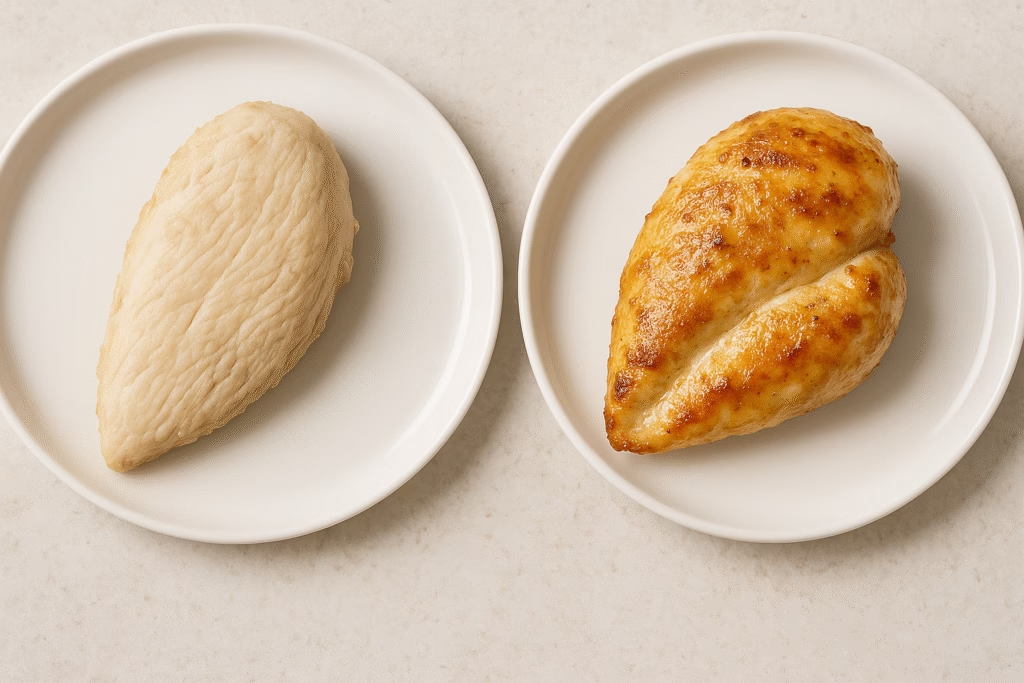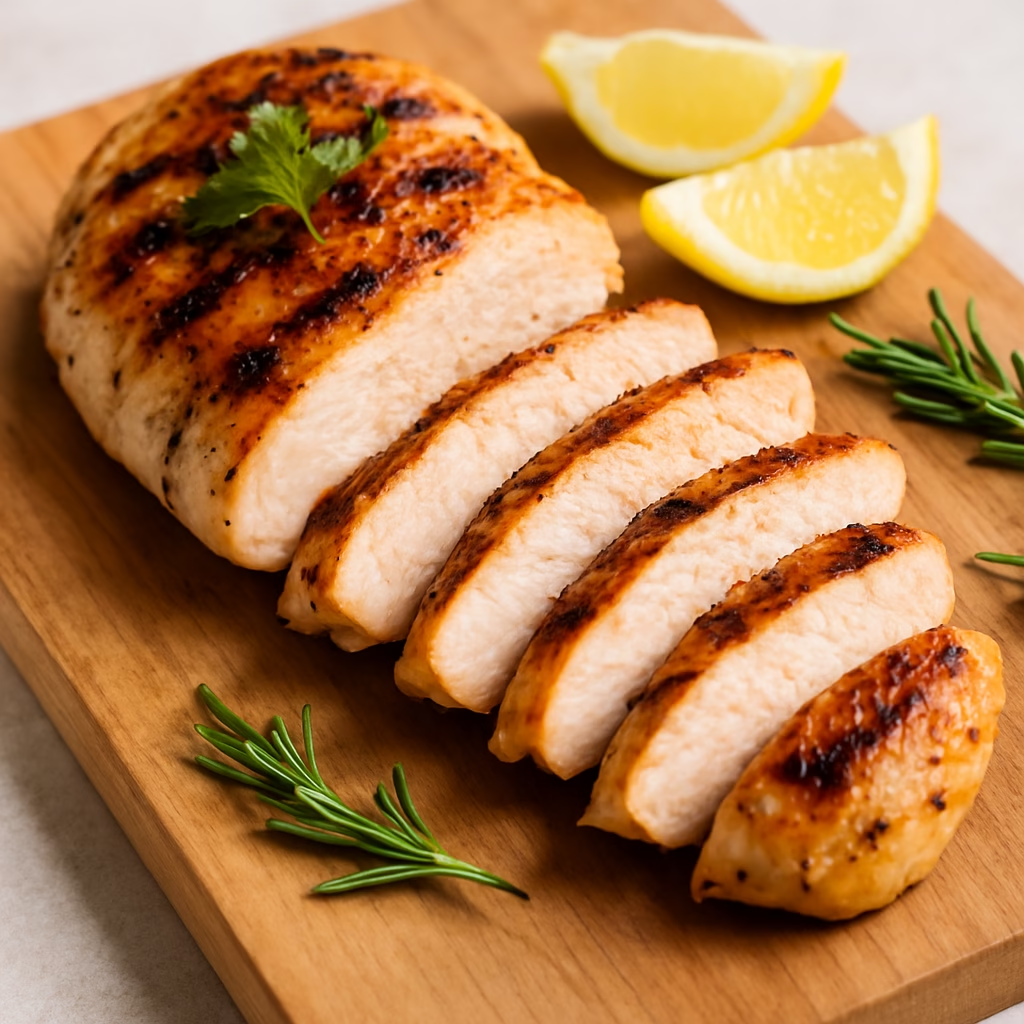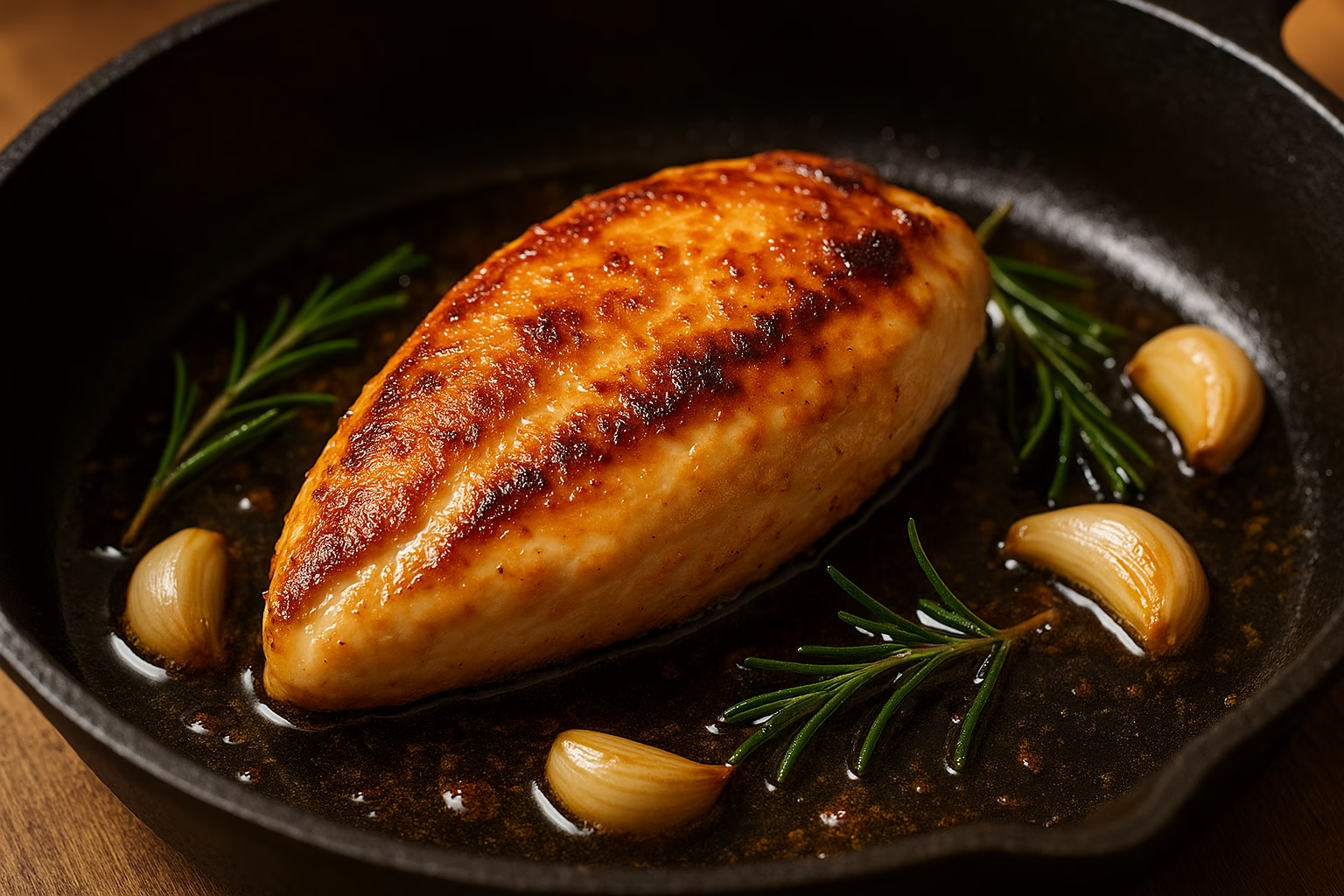Introduction: How to Cook Chicken Breast the Right Way
Learning how to cook chicken breast properly can transform your everyday meals.
This lean protein is a household favorite, yet many people struggle with keeping it juicy and
flavorful. Too often, chicken turns out dry or bland, leaving you disappointed. The good news
is that with the right techniques, you can master how to cook chicken breast
so it comes out tender every single time. Whether you prefer pan-searing, baking, or grilling,
the fundamentals remain the same: proper preparation, correct cooking time, and seasoning that
enhances natural flavor.
By focusing on temperature control and simple methods, you can avoid the common pitfalls of
overcooking. Understanding how to cook chicken breast also means learning
when to brine, when to marinate, and how to rest the meat so it stays moist. These small steps
make a big difference in achieving perfect results.
In this guide, we’ll cover every aspect of how to cook chicken breast—from
choosing the right cut at the store, to seasoning combinations, to tried-and-tested cooking
techniques. You’ll also find a step-by-step process you can follow at home. By the end, you’ll
not only know how to cook chicken breast but also how to adapt the process
to fit your taste and cooking style.
Different Cooking Methods for Chicken Breast
There are multiple ways to master how to cook chicken breast, and each method
brings out unique textures and flavors. The key is to understand how different cooking styles
affect moisture, tenderness, and taste. By experimenting, you’ll discover the best option that
suits your preferences while avoiding dryness.
One of the most common methods is pan-searing. It is a fast way to prepare dinner and ideal for
busy weeknights. Heat a skillet with a bit of oil, place the seasoned chicken in, and cook for
about 6–8 minutes per side depending on thickness. To truly master how to cook chicken
breast, remember not to overcrowd the pan and to let it rest afterward so juices
redistribute. This method produces a golden crust while keeping the inside juicy when done right.
Baking is another popular approach. By using the oven, you have better temperature control.
Place the chicken in a preheated oven at 375°F (190°C) for 20–25 minutes, depending on size.
Always check the internal temperature with a meat thermometer, ensuring it reaches 165°F (74°C).
Understanding how to cook chicken breast in the oven gives you consistently
tender results, and adding foil or parchment paper can help preserve moisture.
Grilling is excellent for smoky flavors and a slightly charred exterior. Preheat the grill,
oil the grates, and cook each side for about 5–6 minutes. Learning how to cook chicken
breast on the grill is also about timing and avoiding flare-ups. Using a marinade
beforehand prevents sticking and adds extra taste.
Finally, poaching is a gentle method that keeps chicken moist. Simmer the breasts in seasoned
water or broth for about 15 minutes. This technique is ideal for salads, sandwiches, or meal prep.
If you’re exploring how to cook chicken breast in a healthier way, poaching
avoids excess oil and delivers a mild, versatile flavor.
Whether pan-seared, baked, grilled, or poached, each method offers a delicious result if done
correctly. By trying all these approaches, you’ll soon master how to cook chicken breast
to perfection.
Choosing and Preparing Chicken Breast
Before you even start learning how to cook chicken breast, it’s essential to know
how to select the right cut at the store. Freshness is key. Look for chicken that is pink in color,
without any gray spots or foul odor. Boneless, skinless chicken breasts are the most versatile option,
but you may also find bone-in versions that retain extra flavor. When choosing, also pay attention
to size and thickness, since these factors directly impact cooking time. Knowing how to cook
chicken breast starts with making smart choices at this stage.
Once you bring it home, preparation is just as important. Trimming excess fat, cartilage, or tendon
pieces will improve both taste and presentation. If the breasts are uneven in thickness, consider
pounding them to a uniform size using a mallet. This step ensures that when you learn
how to cook chicken breast, the meat will cook evenly without leaving one end dry
and the other undercooked.
Another critical step is brining or marinating. A quick brine with water and salt helps lock in
moisture, while a marinade adds flavor and tenderness. Even thirty minutes can make a big difference.
Marinating in lemon juice, olive oil, garlic, and herbs is a simple way to enhance your experience
with how to cook chicken breast. Remember that acids like vinegar or citrus should
not be left for too long, or they can toughen the meat.
Seasoning is the final step before heat touches the pan or oven. Salt and pepper are essential, but
adding paprika, chili flakes, or rosemary can elevate the taste. For those experimenting with
different cuisines, spices like turmeric, cumin, or oregano pair well too. Once seasoned, let the
chicken rest at room temperature for 10–15 minutes before cooking. This ensures that when you master
how to cook chicken breast, the meat will not go into shock when exposed to high heat.
Overall, choosing and preparing correctly sets the foundation for success. By paying attention to
freshness, trimming, even thickness, and seasoning, you’ll already be halfway toward perfecting
how to cook chicken breast every time.
Step-by-Step Guide: How to Cook Chicken Breast Perfectly
Step 1: Preparing and Seasoning the Chicken
The first step in learning how to cook chicken breast is preparation. A lot
of people underestimate this stage, but it’s here that you set the foundation for success.
Begin by rinsing the chicken breasts under cold water and patting them dry with paper towels.
Drying is crucial because moisture on the surface will prevent browning and can cause the meat
to steam instead of sear. When you’re focused on how to cook chicken breast,
always think about surface texture and cleanliness.
Once dry, trim away any visible fat or connective tissue. If the chicken breast is uneven in
thickness, use a meat mallet or rolling pin to gently pound it out until it’s even. This not
only promotes faster and more consistent cooking but also prevents one side from drying out
while the other side is undercooked. Anyone trying to master how to cook chicken breast
should remember that uniform thickness equals consistent results.
After trimming and flattening, it’s time to brine or marinate. A simple brine of salt and water
for 30 minutes locks in moisture and guarantees a juicier result. If you prefer more flavor, a
marinade with olive oil, lemon juice, garlic, and herbs is a reliable choice. The acid tenderizes
the chicken slightly while the oil helps in searing. When understanding how to cook
chicken breast, it’s important to note that marination time should not exceed two hours
if acids like lemon or vinegar are involved, as prolonged exposure can toughen the meat.
Finally, season the chicken generously. Salt and pepper are the essentials, but you can build on
that with paprika, onion powder, oregano, or chili flakes depending on your preferred flavor
profile. Seasoning should not be skipped; it’s the element that defines the taste of your meal.
With this preparation step complete, you’re one step closer to mastering how to cook
chicken breast with confidence and flavor.

Step 2: Cooking with the Right Method and Temperature
Once your chicken is prepared and seasoned, the next part of learning how to cook
chicken breast is applying heat correctly. The method you choose—pan-searing, baking,
grilling, or poaching—directly influences the flavor and texture of the final dish. Each method
has its own strengths, but temperature control is the non-negotiable factor.
If you’re pan-searing, preheat your skillet on medium-high and add oil before placing the chicken.
Don’t overcrowd the pan—this ensures a golden crust instead of steaming. Cook each side for 6–8
minutes depending on thickness. For those exploring how to cook chicken breast
in the oven, set the temperature to 375°F (190°C) and bake for 20–25 minutes. Use a baking sheet
lined with parchment or foil to prevent sticking and promote even cooking. Covering loosely with
foil also helps retain moisture.
Grilling requires preheating the grill and oiling the grates. Cook each side for 5–6 minutes
while keeping the lid closed to trap heat. Avoid pressing the chicken with a spatula, as this
releases precious juices. Understanding how to cook chicken breast on the grill
also means recognizing when it’s done: the internal temperature should reach 165°F (74°C).
Poaching, on the other hand, is gentler. Place the chicken in simmering (not boiling) broth or
water with aromatics like bay leaves and garlic. Simmer for 15 minutes until cooked through. This
approach is ideal for meal prep, as it keeps the chicken moist and versatile.
No matter which method you use, the universal rule in learning how to cook chicken
breast is to use a meat thermometer. It ensures safety and prevents overcooking. With
this step complete, you’ll achieve consistent, flavorful results that prove you’ve mastered
the cooking process.
Step 3: Resting, Serving, and Storing
The final step in learning how to cook chicken breast is often overlooked:
resting, serving, and storing. Once you remove the chicken from the heat source, it’s crucial
to let it rest for at least 5–10 minutes. During this time, the juices that moved to the
surface while cooking redistribute back into the fibers. If you cut into the meat too soon,
you’ll lose all that moisture, resulting in a dry dish despite cooking it correctly. So,
understanding how to cook chicken breast properly means respecting this
final resting stage.
After resting, slice the chicken against the grain for maximum tenderness. This technique shortens
the muscle fibers, making each bite easier to chew. Presentation matters too—pair your chicken
with colorful vegetables, grains, or pasta to balance nutrition and flavor. When teaching someone
else how to cook chicken breast, always highlight the importance of cutting and
plating, as it elevates even the simplest meal.
Storage is another critical aspect. If you’ve cooked more than you can eat in one sitting, let
the chicken cool completely before refrigerating. Store in airtight containers for up to four
days, or freeze for up to three months. To reheat without drying out, use a gentle method such
as steaming or warming in a covered pan with a splash of broth. This knowledge is vital for
anyone practicing how to cook chicken breast regularly, especially those
meal-prepping for the week.
Beyond storage, think about versatility. Cooked chicken breast can be repurposed into salads,
wraps, soups, or casseroles. By mastering not just the cooking but also the aftercare, you
ensure your hard work pays off for multiple meals. This holistic view of how to cook
chicken breast guarantees you get the most value and enjoyment from your effort.
Common Mistakes to Avoid When Cooking Chicken Breast
Even with the best intentions, many people make avoidable errors when figuring out
how to cook chicken breast. These mistakes often lead to dry, tough, or bland
results. By being aware of them, you can sidestep frustration and consistently prepare
delicious, juicy chicken every time.
The first mistake is overcooking. Because chicken breast is naturally lean, it dries out
quickly. Cooking past the safe internal temperature of 165°F (74°C) causes proteins to tighten
and squeeze out moisture. To truly master how to cook chicken breast, invest
in a meat thermometer and remove the chicken from heat the moment it reaches the correct
temperature. Remember, carryover cooking adds a few extra degrees as the meat rests.
Another common error is skipping the preparation steps. Not trimming, pounding, or seasoning
properly creates uneven results. Thick ends remain undercooked while thinner parts dry out.
If you want consistent success with how to cook chicken breast, preparation
is just as important as cooking technique. Always ensure uniform thickness and season generously.
Many people also use heat that is too high. While a strong sear can create a flavorful crust,
leaving chicken over high heat for too long burns the outside while the inside remains raw.
A balanced approach with medium-high heat is best. Understanding how to cook chicken
breast means learning how to control heat rather than blasting it.
Resting the chicken is another step often skipped. Cutting into it immediately causes the
juices to run out, leaving the meat dry. Allowing the chicken to rest for 5–10 minutes makes
a big difference. This detail is often overlooked by beginners who are eager to taste their
results, but it’s central to knowing how to cook chicken breast the right way.
Lastly, improper storage ruins good cooking. Leaving cooked chicken at room temperature for
hours or refrigerating it while still hot leads to bacterial risks and poor texture. Safe
storage ensures that your effort in learning how to cook chicken breast
doesn’t go to waste.
By avoiding these mistakes—overcooking, poor prep, high heat misuse, skipping rest, and
unsafe storage—you’ll refine your skills and truly understand how to cook chicken breast.
Conclusion: Mastering How to Cook Chicken Breast
By now, you’ve explored every essential detail about how to cook chicken breast,
from choosing the right cut at the store to seasoning, cooking, and storing it correctly. The
journey may seem simple on the surface, but as you’ve learned, the difference between dry, bland
chicken and juicy, flavorful chicken lies in a handful of crucial techniques. Mastering
how to cook chicken breast means paying attention to each stage, not just the
time spent over the stove or oven.

The most important lessons to take away are consistency and patience. Preparing evenly sized
portions, seasoning generously, and monitoring cooking temperature are habits that guarantee
better results. Adding in steps like brining, resting, and cutting against the grain elevate
the meal from average to exceptional. Once you’ve internalized these small but powerful details,
you’ll realize that knowing how to cook chicken breast is about more than
following a recipe—it’s about building good cooking instincts.
Another key aspect is flexibility. Whether you prefer pan-searing for quick weekday dinners,
baking for meal prep, grilling for smoky flavors, or poaching for healthier choices, there’s
no single best way. Understanding how to cook chicken breast empowers you to
adapt the process to your needs, your taste, and the occasion. This adaptability ensures that
chicken breast never feels repetitive on your menu.
Finally, remember that practice makes perfect. The more often you prepare chicken, the more
confident you’ll become at adjusting cook times, experimenting with seasonings, and avoiding
mistakes. Over time, how to cook chicken breast will become second nature,
and you’ll be able to create consistently delicious meals without even thinking about the
process.
In short, the real secret to mastering how to cook chicken breast is balance:
balancing preparation with technique, heat with patience, and flavor with simplicity. Once you
find that balance, you’ll never again worry about dry or tasteless chicken. Instead, you’ll
enjoy perfectly cooked, versatile, and satisfying meals every time.
Frequently Asked Questions
1. How long should I cook chicken breast?
When learning how to cook chicken breast, time depends on thickness and method.
For pan-searing, cook 6–8 minutes per side. In the oven at 375°F (190°C), 20–25 minutes usually
works. On the grill, 5–6 minutes per side is common. Regardless of the method, always check the
internal temperature—it must reach 165°F (74°C) to be safe. Timing is only a guide; temperature
is the true measure when figuring out how to cook chicken breast.
2. Should I brine or marinate chicken breast?
Both methods improve flavor and texture. Brining with salt water ensures moisture, while marinades
add flavor through herbs, spices, and acids like lemon juice. If you’re focused on
how to cook chicken breast for maximum juiciness, even a quick 30-minute brine
helps. Marinating, on the other hand, gives you flexibility to match global cuisines. Whether
you choose brining or marinating, preparation is the step that separates average results from
great ones in how to cook chicken breast.
3. How do I keep chicken breast from drying out?
The biggest challenge in how to cook chicken breast is avoiding dryness. Start
with even thickness, avoid cooking past 165°F (74°C), and always let the meat rest for 5–10 minutes
before slicing. Another trick is covering baked chicken loosely with foil or adding broth when
reheating. These small habits ensure that once you’ve learned how to cook chicken breast,
you can consistently enjoy juicy results rather than disappointment.
4. Can I meal prep chicken breast?
Yes. Many people exploring how to cook chicken breast do so with meal prep in mind.
Cooked chicken can be stored in the refrigerator for four days or frozen for three months. To reheat,
use gentle methods like steaming or warming in broth instead of microwaving on high. This prevents
the chicken from becoming rubbery. Meal prepping with chicken breast ensures you always have a lean,
protein-rich base ready for salads, wraps, or rice bowls.
5. What’s the healthiest way to cook chicken breast?
If your goal in learning how to cook chicken breast is health-focused, poaching
or baking are the top methods. Both require little or no added fat. Poaching in broth creates tender,
flavorful meat without extra calories, while baking allows for herbs and spices to shine. Grilling is
also healthy when done carefully, as excess fat drips away during cooking. Each option can be part of
a balanced diet if you understand how to cook chicken breast correctly.
Read Similar Topics
Share this:
- Click to share on Facebook (Opens in new window) Facebook
- Click to share on X (Opens in new window) X
- Click to share on LinkedIn (Opens in new window) LinkedIn
- Click to share on Reddit (Opens in new window) Reddit
- Click to share on X (Opens in new window) X
- Click to share on Threads (Opens in new window) Threads
- Click to share on WhatsApp (Opens in new window) WhatsApp




